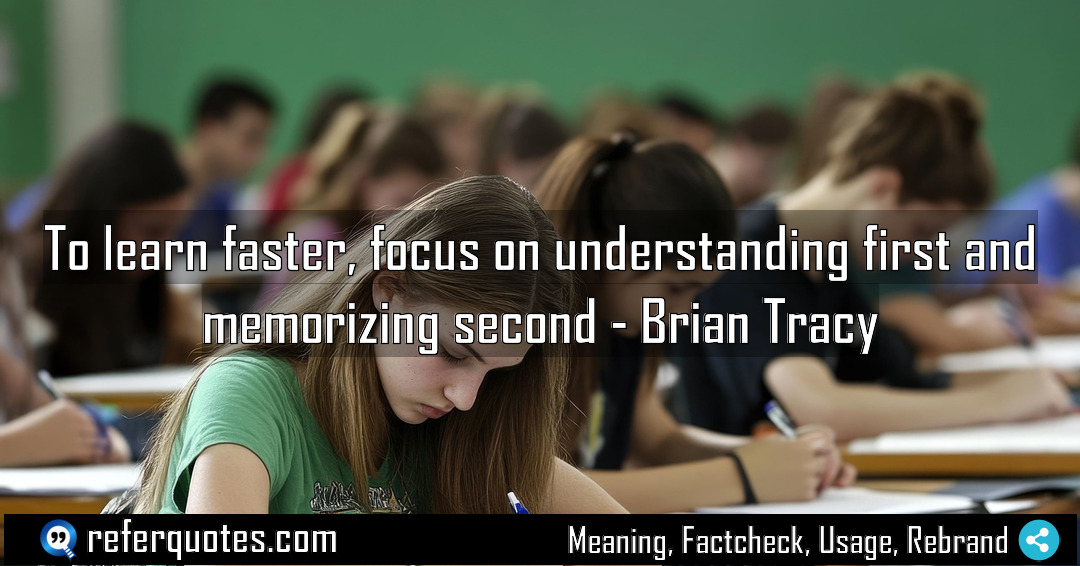
To learn faster, focus on understanding first. It’s the secret weapon most people ignore because they’re stuck in the old school cram-and-forget cycle. This approach flips the entire learning process on its head for much better results.
Share Image Quote:
Table of Contents
Meaning
The core message is simple: true speed in learning doesn’t come from frantic memorization, but from building a solid foundation of comprehension first.
Explanation
Let me break this down for you. Think of your brain like a filing cabinet. If you just memorize facts—names, dates, formulas—you’re just shoving papers into folders with no labels. Good luck finding anything when you need it, right? It’s a mess. But when you understand the ‘why’ behind something, you’re creating a beautifully organized, cross-referenced system. You see how concepts connect. Suddenly, that one piece of information has multiple pathways for you to retrieve it. It sticks. And the crazy part? The memorization often happens almost automatically as a byproduct of that deep understanding. You’re not forcing it; it just… clicks into place.
Quote Summary
Reading Level58
Aesthetic Score83
Origin & Factcheck
This wisdom comes straight from Brian Tracy and Colin Rose’s book, Accelerated Learning Techniques for Students. It’s a key principle from their system developed to help students learn more effectively. You might sometimes see similar sentiments floating around, but this specific phrasing is correctly attributed to their work.
Attribution Summary
Author Bio
Brian Tracy, a prolific author gained global reputation because of his best seller book list such as Eat That Frog!, Goals!, and The Psychology of Selling, and created influential audio programs like The Psychology of Achievement. He is sought after guru for personal development and business performance. Brian Tracy International, coaches millions of professionals and corporates on sales, goal setting, leadership, and productivity.
Official Website |Facebook | X | Instagram | YouTube |
Where is this quotation located?
| Quotation | To learn faster, focus on understanding first and memorizing second |
| Book Details | Publication Year/Date: 1999; ISBN: 978-1576751402; Last Edition: Berrett-Koehler Publishers, 1999; Number of Pages: 176 |
| Where is it? | Chapter 10: The Science of Comprehension, Page 81 / 176 |
Context
In the book, this isn’t just a passing comment. It’s the bedrock of their entire accelerated learning methodology. They argue that traditional education often gets it backwards, prioritizing rote recall over genuine comprehension, which is why so many people struggle to retain what they’ve “learned.”
Usage Examples
So how do you actually *use* this? It’s a game-changer for a few key audiences.
For the student cramming for an exam: Instead of just rereading your notes, stop after each paragraph and ask, “Can I explain this concept to a 10-year-old?” If you can’t, you don’t understand it yet. Go back. The act of simplifying it in your own mind forces that deep understanding.
For the professional learning a new software: Don’t just memorize the sequence of clicks. Ask, “Why is this button here? What problem is it solving in the workflow?” When you grasp the logic, you’re not just following steps—you’re operating the system.
For the anyone learning a language: Instead of purely memorizing vocabulary lists, learn the root words and common prefixes/suffixes. Understanding the structure of the language helps you decode new words you’ve never even seen before.
To whom it appeals?
Share This Quote Image & Motivate
Motivation Score87
Popularity Score86
Shareability Score88
FAQ
Question: But don’t some things just require pure memorization, like medical terms or law articles?
Answer: Absolutely, there’s a place for it. But even then, understanding the Latin root of a medical term or the historical precedent for a law creates a hook for that memory to hang on, making it far more durable than random, disconnected facts.
Question: Isn’t this understanding-first approach slower at the beginning?
Answer: It can feel that way initially, and that’s the trap. You have to push through that initial feeling of slowness. But it’s like sharpening your axe before chopping wood. That upfront investment pays off massively in the long run because you’re not constantly going back to re-learn what you forgot.
Question: How do I know when I truly “understand” something?
Answer: The Feynman Technique is a great test. Try to teach it to someone else, or even just explain it out loud to yourself. If you can do it simply, without jargon, and field questions about it, you’ve got it. If you stumble, you’ve found the gaps in your understanding.
Similar Quotes
If you want to learn faster, teach what you know. It sounds counterintuitive, but this simple switch from passive consumption to active explanation is the secret weapon for rapid, durable…
You know, “Preparation is half of learning” is one of those truths that seems obvious once you hear it, but it completely changes your approach to studying. It’s the difference…
You know, I’ve seen this principle in action for years. To learn effectively, turn information into action is the secret sauce most people miss. They consume content without applying it,…
You know, the more senses you involve in learning… it’s not just a nice idea, it’s neuroscience. Your brain literally builds a stronger, more durable memory when you give it…
You know, the key to accelerated learning is your attitude isn’t just a motivational poster line. It’s the absolute foundation. I’ve seen it time and again—the students and professionals who…
